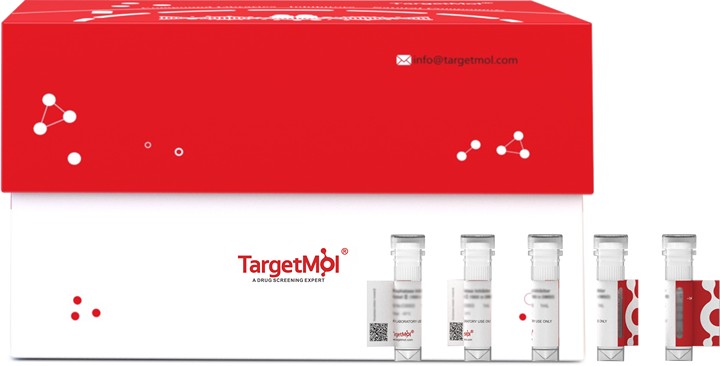Shopping Cart
- Remove All
 Your shopping cart is currently empty
Your shopping cart is currently empty

Chikungunya virus (strain S27-African prototype) Non-structural protein 4 (His) is expressed in E. coli expression system with N-6xHis tag. The predicted molecular weight is 31.1 kDa and the accession number is Q8JUX6.

| Pack Size | Price | Availability | Quantity |
|---|---|---|---|
| 20 μg | $360 | 20 days | |
| 100 μg | $745 | 20 days | |
| 1 mg | $2,530 | 20 days |
| Biological Activity | Activity has not been tested. It is theoretically active, but we cannot guarantee it. If you require protein activity, we recommend choosing the eukaryotic expression version first. |
| Description | Chikungunya virus (strain S27-African prototype) Non-structural protein 4 (His) is expressed in E. coli expression system with N-6xHis tag. The predicted molecular weight is 31.1 kDa and the accession number is Q8JUX6. |
| Species | CHIKV |
| Expression System | E. coli |
| Tag | N-6xHis |
| Accession Number | Q8JUX6 |
| Synonyms | Polyprotein P1234,P1234,Non-structural polyprotein |
| Amino Acid | DTVLETDIASFDKSQDDSLALTALMLLEDLGVDHSLLDLIEAAFGEISSCHLPTGTRFKFGAMMKSGMFLTLFVNTLLNITIASRVLEDRLTKSACAAFIGDDNIIHGVVSDELMAARCATWMNMEVKIIDAVVSQKAPYFCGGFILHDIVTGTACRVADPLKRLFKLGKPLAAGDEQDEDRRRALADEVVRWQRTGLIDELEKAVYSRYEVQGISVVVMSMATFASSRSNFEKLRGPVVTLYGGPK |
| Construction | 2228-2474 aa |
| Protein Purity | > 90% as determined by SDS-PAGE. |
| Molecular Weight | 31.1 kDa (predicted) |
| Endotoxin | < 1.0 EU/μg of the protein as determined by the LAL method. |
| Formulation | Tris-based buffer, 50% glycerol |
| Reconstitution | A Certificate of Analysis (CoA) containing reconstitution instructions is included with the products. Please refer to the CoA for detailed information. |
| Stability & Storage | Lyophilized powders can be stably stored for over 12 months, while liquid products can be stored for 6-12 months at -80°C. For reconstituted protein solutions, the solution can be stored at -20°C to -80°C for at least 3 months. Please avoid multiple freeze-thaw cycles and store products in aliquots. |
| Shipping | In general, Lyophilized powders are shipping with blue ice. Solutions are shipping with dry ice. |
| Research Background | Inactive precursor of the viral replicase, which is activated by cleavages carried out by the viral protease nsP2.; The early replication complex formed by the polyprotein P123 and nsP4 synthesizes minus-strand RNAs. As soon P123 is cleaved into mature proteins, the plus-strand RNAs synthesis begins.; Cytoplasmic capping enzyme that catalyzes two virus-specific reactions: methyltransferase and guanylyltransferase. mRNA-capping is necessary since all viral RNAs are synthesized in the cytoplasm, and host capping enzymes are restricted to the nucleus (Probable). The enzymatic reaction involves a covalent link between 7-methyl-GMP and nsP1, whereas eukaryotic capping enzymes form a covalent complex only with GMP. nsP1 capping consists in the following reactions: GTP is first methylated into 7-methyl-GMP and then is covalently linked to nsP1 to form the m7GMp-nsP1 complex from which 7-methyl-GMP complex is transferred to the mRNA to create the cap structure. NsP1 is also needed for the initiation of the minus-strand RNAs synthesis. At the initiation of virus replication, mediates the assembly of the viral replication complex made of the non-structural proteins, the association of this complex with the inner face of the plasma membrane and the formation of membranous spherules that serve as replication complex factories. Forms the neck of these spherules with a central channel for mediating communication and the passage of RNA, nucleotides, and small proteins between the viral replication complex and the host cytoplasm. Palmitoylated nsP1 is remodeling host cell cytoskeleton, and induces filopodium-like structure formation at the surface of the host cell.; Multifunctional protein whose N-terminus is part of the RNA polymerase complex and displays NTPase, RNA triphosphatase and helicase activities. NTPase and RNA triphosphatase are involved in viral RNA capping and helicase keeps a check on the dsRNA replication intermediates. The C-terminus harbors a protease that specifically cleaves the polyproteins and releases the mature proteins. Required for the shutoff of minus-strand RNAs synthesis. Specifically inhibits the host IFN response by promoting the nuclear export of host STAT1. Also inhibits host transcription by inducing the rapid proteasome-dependent degradation of POLR2A, a catalytic subunit of the RNAPII complex. The resulting inhibition of cellular protein synthesis serves to ensure maximal viral gene expression and to evade host immune response (Probable).; Seems to be essential for minus-strand RNAs and subgenomic 26S mRNAs synthesis. Displays mono-ADP-ribosylhydrolase activity. ADP-ribosylation is a post-translational modification that controls various processes of the host cell and the virus probably needs to revert it for optimal viral replication. Binds proteins of G3BP family and sequesters them into the viral RNA replication complexes thereby inhibiting the formation of host stress granules on viral mRNAs. The nsp3-G3BP complexes bind viral RNAs and probably orchestrate the assembly of viral replication complexes, thanks to the ability of G3BP family members to self-assemble and bind DNA (Probable).; RNA dependent RNA polymerase. Replicates genomic and antigenomic RNA by recognizing replications specific signals. The early replication complex formed by the polyprotein P123 and nsP4 synthesizes minus-strand RNAs. The late replication complex composed of fully processed nsP1-nsP4 is responsible for the production of genomic and subgenomic plus-strand RNAs. |

Copyright © 2015-2025 TargetMol Chemicals Inc. All Rights Reserved.